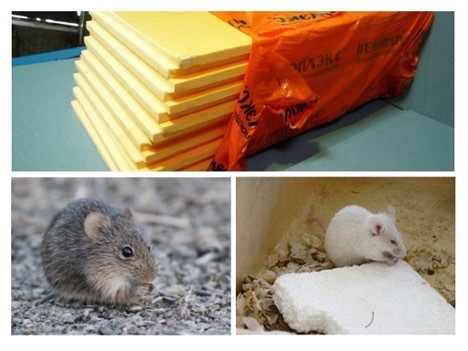In modern construction, various insulation materials are widely used, among which foam plastic and penoplex are popular. These materials have excellent thermal insulation properties, lightness and ease of installation. However, like many other insulation materials, foam and polystyrene foam can attract pests such as mice.

The presence of rodents in the walls or floor of your home is not only unpleasant, but can also lead to deterioration of the thermal insulation properties of the insulation and damage to other building structures. Pest control and protection of insulation materials from them is an important part of ensuring the long-term performance and effectiveness of insulation work. In this article we will look at whether mice prefer materials such as polystyrene foam and polystyrene foam, and we will also look at what measures can be taken to protect insulation from rodents.
The content of the article
-
Do mice eat penoplex?
- Which areas are at risk?
-
Do mice eat foam?
- How to protect foam from mice and rats
- Do mice eat polystyrene foam?
- What mice don't chew
Do mice eat penoplex?
During construction and renovation, a material such as penoplex is often used. It has good thermal insulation properties, lightness and ease of installation. However, despite all its advantages, there is a problem of interaction of rodents with this material. The question of whether mice eat penoplex is of concern to many homeowners, since the presence of rodents in the building structure can cause serious problems.
Mice are well-known “lovers” of various construction and finishing materials. However, not all materials are equally attractive to them. Mice chew on penoplex not because rodents like the taste of this material, but because of the warmth and comfort that it creates. Mice can chew on penoplex to create a cozy shelter for themselves, because this material retains heat well.
Which areas are at risk?
The most vulnerable areas are near the floor and in the corners of rooms, since this is where mice most often try to create their “homes.” They chew penoplex, making passages and cavities in it. In addition, damp and warm rooms are especially attractive to rodents, which increases the risk of damage to the insulation.
The problem of interaction between mice and penoplex can be solved by applying some simple measures. Firstly, it is recommended to use special antiseptics and repellents against rodents. Secondly, it is worth paying attention to the physical protection of penoplex - metal mesh or cladding with wooden boards.
There are several effective ways to protect penoplex from rodents:
- Use of repellents (deterrents).
- Installation of metal mesh on vulnerable areas.
- Cover corners and areas near the floor with wooden boards or other rodent-resistant materials.
Penoplex is an excellent insulation material, but its interaction with mice can be a serious problem. By taking simple precautions and regularly inspecting the insulation for damage, you can avoid unwanted “surprises” from little uninvited guests.
Do mice eat foam?
The issue of interaction between polystyrene foam and mice is quite relevant, especially for those who use this material to insulate their home or for other construction needs. Polystyrene foam is a fairly popular material due to its thermal insulation properties and availability. However, its use may attract rodents, which, in turn, may necessitate repair work.
It is believed that mice chew polystyrene foam not because of its taste, but because of the softness and lightness of the material, which allows them to create passages and shelters in it. In addition, polystyrene foam retains heat well, which is especially appreciated by rodents during the cold season. The answer to the question why mice love foam plastic is that it provides them with a comfortable living environment. However, the damage that mice can cause when moving through foam plastic can be significant, as this degrades the thermal insulation properties of the material and can lead to its further destruction.
The problem of protecting polystyrene foam from rodents can be a serious challenge for home owners and builders. There is a solution to this problem, more on this below.
How to protect foam from mice and rats
The problem of protecting polystyrene foam from rodents may be relevant for many owners of private houses and summer residents. Polystyrene foam is lightweight and porous, which makes it a convenient material for construction and insulation; however, these same properties attract rodents. In order to ensure protection of polystyrene foam from mice and rats, it is necessary to use a number of methods. First of all, it is recommended to use repellents - special deterrents that can be applied to the surface of the foam. These products have a rodent-repellent odor. It is important to choose repellents that are safe for people and pets and will not harm the foam itself.
Another way to protect foam from rodents is to use metal mesh or gratings that can be installed around the insulation. These structures create a physical barrier for rodents, preventing them from entering the material. You may also want to consider using more rodent-resistant materials in areas where mice and rats are likely to be present. For example, you can use stiffer, harder materials for insulation or sheathing in areas where rodents are likely to infest. Thanks to an integrated approach to solving this problem, it is possible to significantly reduce the risk of damage to the foam and preserve the thermal insulation properties of the insulation for a long time.
Do mice eat polystyrene foam?

Expanded polystyrene is a material that is often used in construction due to its excellent thermal insulation properties. However, the issue of interaction between polystyrene foam and rodents is very relevant for owners of private houses and summer cottages. It should be understood that mice and rats may chew on polystyrene foam not because of its taste, but in search of shelter or food.
Rodents such as mice and rats strive to find a warm and sheltered place where they can escape the cold and predators. Expanded polystyrene with its porous structure can provide an attractive place for them to enter and build a nest. However, they do not consume this material as food, but use it as shelter or simply chew it, trying to get through obstacles in their path.
Various types of polystyrene foam, including extruded polystyrene foam, can be affected by rodents to varying degrees. Extruded polystyrene foam has a denser structure than regular polystyrene foam, which can make it more difficult for rodents, but does not make it completely resistant to rodents.
To protect polystyrene foam from rodents, you can use various repellents or mechanical barriers, such as metal mesh. This will help reduce the likelihood of damage to the material and improve its durability under operating conditions.
What mice don't chew
Rodents, including mice, have sharp teeth that allow them to chew on many materials. However, there are certain materials and substances that pose serious obstacles to them. Let's look at what mice cannot chew through:
- Steel, iron and aluminum surfaces are irresistible to rodents.
- Glass is another material that rodents cannot chew through.
- The hardness of the brick makes it inaccessible to rodents.
- Concrete is a hard and impermeable material just like brick.
- Natural stones are also rodent resistant.
There are also specialized coatings and additives that make materials resistant to rodents. For example, adding special repellents to wood or plastic can make these materials less attractive to rodents.
Now, knowing which materials are irresistible to rodents, you can more effectively protect your home or other buildings from their invasion. It is important to remember that the best defense against rodents is to prevent their entry, create barriers and use repellents.


